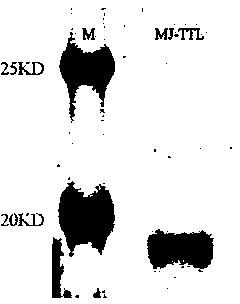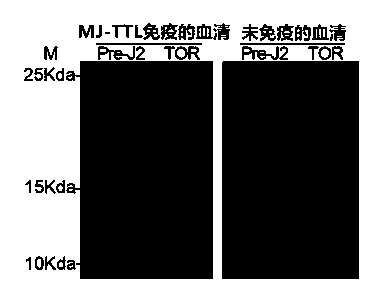Meloidogyne jauanica effect gene Mj-ttl, encoded protein and application of meloidogyne jauanica effect gene Mj-ttl
A Java root-knot nematode and effector gene technology, applied in application, genetic engineering, plant genetic improvement and other directions, can solve the problems of lack of similarity in function, TTL protein cannot achieve TTR, etc., and achieves significant theoretical value, good theory and guiding significance Effect
- Summary
- Abstract
- Description
- Claims
- Application Information
AI Technical Summary
Problems solved by technology
Method used
Image
Examples
Embodiment 1
[0053] Example 1 Mj-ttl Acquisition of full-length gene sequence and sequence analysis
[0054] 1, Mj-ttl Acquisition of mid-gene fragments
[0055] According to the homologous genes in the NCBI gene bank, degenerate primers ttlestF (sequence shown in SEQ ID NO: 5) and ttlestR (sequence shown in SEQ ID NO: 6) were designed, and the cDNA of M. javanica was used as a template for PCR amplification. increase.
[0056] The PCR reaction system is 25 μL: cDNA 1 μL, ddH 2 O 17.875μL, dNTP Mixture(2.5mmoL / L each) 2.5μL, 10×PCR Buffer 2.5μL, littlestF(10μmoL / L) 0.5μL, littlestR(10μmoL / L) 0.5μL, Ex Taq(5U / μL) 0.125μL .
[0057] The PCR reaction program was: 94°C for 1min; 30 cycles of 94°C for 30s, 60°C for 50s, 72°C for 1min; 72°C for 10min, 4°C, ∞.
[0058] 2, Mj-ttl Amplification of gene 3'RACE
[0059] (1) Primers: according to the amplified Mj-ttlTwo specific primers ttl3r1 (sequence shown in SEQ ID NO: 7) and ttl3r2 (sequence shown in SEQ ID NO: 8) were designed for the...
Embodiment 2
[0074] Example 2 Mj-ttl Immunological localization of genes in C. elegans
[0075] The primary antibody used for immunolocalization in this example is the MJ-TTL protein obtained by prokaryotic expression and purification using pET28a, and the antiserum obtained by immunizing rabbits. The secondary antibody was HRP-labeled goat anti-rabbit IgG antibody (provided by Beijing Boaosen Biotechnology Co., Ltd.).
[0076] 1. Preparation of primary antibody:
[0077] (1) Vector construction: amplify using primers ttlFYEcorI (sequence shown in SEQ ID NO: 13) and ttlRYHind (sequence shown in SEQ ID NO: 14) Mj-ttl fragment, using EcroR I and Hind III was digested, connected to the pET28a vector that had been digested with the same enzyme, and the pET28-ttl vector was obtained after sequencing verification, and then transformed into Escherichia coli BL21 (DE3).
[0078] (2) Protein purification: using Ni 2+ -NTA gel to purify the obtained total protein, the specific method refe...
Embodiment 3
[0098] Example 3 Mj-ttl Developmental expression analysis of genes in C. elegans
[0099] 1. Collection of root-knot nematode javanese at different ages
[0100] 2nd instar larvae: Take fresh root knots, use a dissecting microscope to pick out a single egg mass with light yellow or yellow color, culture it in a 28°C incubator for 7 days, transfer it to a test tube and centrifuge to collect nematodes for later use.
[0101] Root-knot nematodes at different developmental stages: Inoculate freshly hatched 2nd instar larvae on 4-week-old tomato roots, pull out the roots of the tomatoes after 24 hours, wash the roots with clean water, and replant the tomato seedlings into new sterilized soil. Pull out the tomatoes at different time periods, collect nematodes and store them in centrifuge tubes for later use.
[0102] 2. Template cDNA: Extract total RNA by referring to the method for extracting total RNA from animal tissue in TIANGEN's RNAprep Micro Kit kit. cDNA was synthesized...
PUM
| Property | Measurement | Unit |
|---|---|---|
| Isoelectric point | aaaaa | aaaaa |
Abstract
Description
Claims
Application Information
 Login to View More
Login to View More - R&D
- Intellectual Property
- Life Sciences
- Materials
- Tech Scout
- Unparalleled Data Quality
- Higher Quality Content
- 60% Fewer Hallucinations
Browse by: Latest US Patents, China's latest patents, Technical Efficacy Thesaurus, Application Domain, Technology Topic, Popular Technical Reports.
© 2025 PatSnap. All rights reserved.Legal|Privacy policy|Modern Slavery Act Transparency Statement|Sitemap|About US| Contact US: help@patsnap.com



